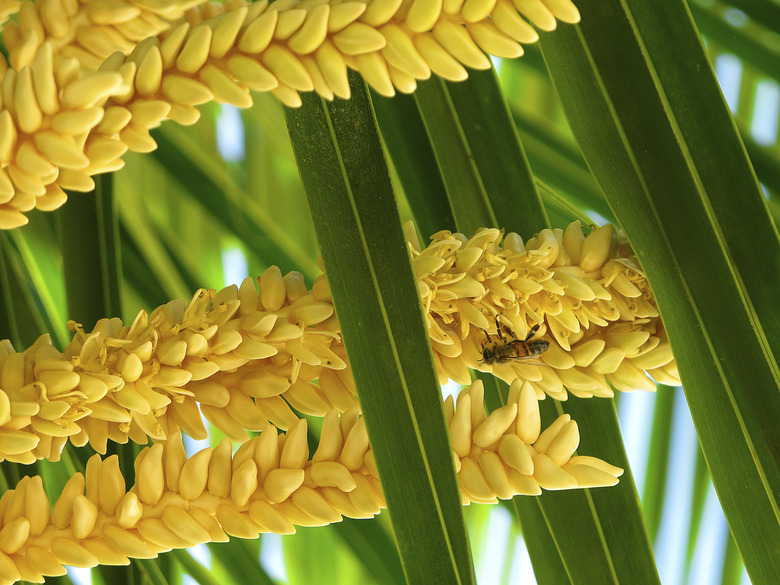How Do Palm Trees Reproduce?
Palm trees are a diverse, complex group of plants, with about 2,500 species of palms, mostly of tropical origin. All of them reproduce using palm tree seeds. For palms with single trunks, it's the only way they reproduce. For palms that cluster or branch, an offset or branch can root to make a new plant.
In order for palm tree seeds to form, pollen from male palm tree flowers transfers to female palm tree flowers, which develop a fruit with a palm tree seed inside. This is sexual reproduction, and keeps the species genetically flexible by using cross-pollination.
Rooting offsets is a form of vegetative reproduction. This process creates genetic duplicates of the parent plant, and can be used to produce offspring that retain specific characteristics of the parent plant.
Flowers and Pollination
Flowers and Pollination
It takes palms anywhere from three to 40 years, depending on the species, to flower for the first time. Palm trees have separate male and female flowers. Sometimes they're on the same plant, and sometimes, as in the date palm (Phoenix dactylifera), the male and female palm tree flowers are on separate trees. Palm trees are not self-pollinating, which means that they need assistance from the wind or pollinators to reproduce sexually.
Date palm trees grow in United States Department of Agriculture (USDA) plant hardiness zones 9 through 11. They're wind-pollinated, but to ensure good fruit set, bring a stalk of male palm flowers to a flowering female tree and dust pollen onto female palm flowers with a cotton pad. Other palms are pollinated by wasps, flies, bees and beetles.
Palm Tree Seeds
Palm Tree Seeds
Once pollen lands on the female palm flower, it fertilizes the female flower's ovary and seed development begins within the ovary walls. The ovary wall produces a fruit that surrounds the seed and is important in eventually carrying the seed away from the mother plant. Mature seeds vary in shape and size, many being hard and oval or round. Some palm seeds are less than an inch in diameter, while others are the largest seeds of any plants.
You usually don't get to observe palm seed formation with the species grown as indoor container palms, because even if they reach flowering size, opportunities for cross-pollination are rare. If you live in a climate where palms can grow to maturity outdoors, you'll frequently see palms set seeds.
Palm Seed Dispersal
Palm Seed Dispersal
In order for each kind of palm to reproduce, the seeds need to find suitable germination spots where they won't compete with the parent. Many palm species have fleshy ovary walls around the seeds that are tasty to wildlife or to humans, perhaps in order to entice animals to carry the seeds as far away from the parent plant as possible, in the process known as seed dispersal.
An example is Canary Island date palm (Phoenix canariensis), which grows in USDA zones 9 through 11. Orange, one-half to one-inch-long fruits attract birds and other wildlife. The fruits are consumed and their fleshy exterior is digested; the seed passes through the animal's digestive tract unharmed, often far away from the parent.
Coconuts (Cocos nucifera) are the ultimate example of long-range seed dispersal. The whole fruit of the coconut palm floats on ocean currents, often for thousands of miles, to find a beach to grow on. Coconut palm is hardy in USDA zones 10b through 11.
Vegetative Palm Reproduction
Vegetative Palm Reproduction
Some palms produce new shoots from near the base of the trunk that can root to become new plants. In the case of date palms, where many named cultivars exist that are valued for the quality of their fruit, this is the only way to faithfully reproduce each variety.
Some palms widely grown as house plants, such as lady palm (Rhapis excelsa) and bamboo palm (Chamaedorea microspadix), produce harvestable offsets. Lady palm grows in USDA zones 8 through 11 and bamboo palm thrives in USDA zones 8 through 11. In order to ensure offspring of variegated lady palm is also patterned with different colors, this species must be propagated by division.
Cite This Article
MLA
Csanyi, Carolyn. "How Do Palm Trees Reproduce?" sciencing.com, https://www.sciencing.com/how-do-palm-trees-reproduce-12170377/. 30 September 2021.
APA
Csanyi, Carolyn. (2021, September 30). How Do Palm Trees Reproduce?. sciencing.com. Retrieved from https://www.sciencing.com/how-do-palm-trees-reproduce-12170377/
Chicago
Csanyi, Carolyn. How Do Palm Trees Reproduce? last modified March 24, 2022. https://www.sciencing.com/how-do-palm-trees-reproduce-12170377/
